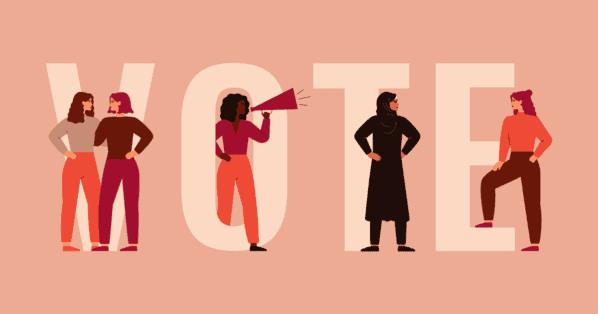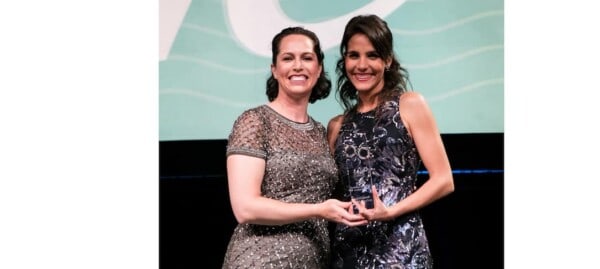A simple raincoat can be a symbol of hope, and this one comes from a future where vast reservoirs of underground carbon are no longer used. At first glance, it’s just an item of apparel everyone needs. It has a faint, golden shimmer — an eerie glow — and learning what it’s made of brings a flood of questions.
“After Ancient Sunlight,” part of the 2018 Cooper Hewitt Design Triennial exhibition “Nature,” and winner of Fast Company’s 2019 Innovation by Design Award in the experimental category, is the creation of designer and researcher Charlotte McCurdy. It’s made of algae, not plastic. Even its thread, snaps, and buttons are made from cellulose fiber and carbon-free brass.
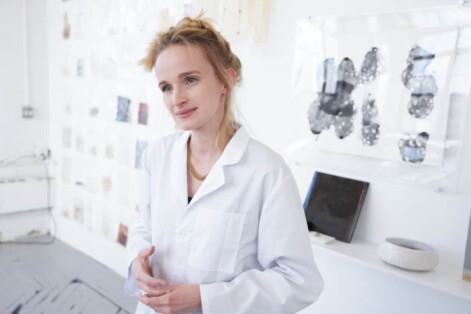
Conventional plastics, along with cements and many other products, are mostly made from petroleum or natural gas-based sources, created from fossilized carbon. “Those molecules contain chemical energy of trapped sunlight that hit the Earth hundreds of millions of years ago,” McCurdy said. “I’m reframing those materials as ‘ancient sunlight,’ by creating something new from sunlight we have right now.
“We want heat and light and amazing materials that help us shelter and clothe ourselves. How can we honor that? By designing new material that doesn’t present a narrative of sacrifice, of returning to a pre-industrial standard of living. Too often, we hear that our desire to protect ourselves and our families is wrong and has caused the climate change, when it’s actually the feedstocks we use to meet those needs that are broken and backward.”
McCurdy designed a raincoat as a work of art, fashion, and science because of its function. “I wanted to make an object from a future, decarbonized society. At the same time, even if we decarbonize tomorrow, we still have to live with the consequences of carbon we’ve already put in the atmosphere. Extreme weather is baked in at this point, and we will have to protect ourselves from it. A raincoat does that — this one imagines a future where we’ve replaced plastics with potentially carbon-negative materials. It’s also unisex, representing a more-inclusive future, unlike other objects that tend to project current norms.”
The raincoat’s “cloth” is derived from marine macroalgae, not microalgae, an important distinction for McCurdy. “There’s a long-standing geoengineering proposal to force microalgae blooms that sequester carbon, but the ecological consequences of blowing up the base of the food chain are unacceptably unknown. I chose macroalgae because it’s also beneficial as a refuge and breeding ground for parts of the food chain that are so stressed right now. It’s a way to expand algae cultivation that is net beneficial to the ecosystem, instead of just creating another extractive frontier.”
With commercially available, refined macroalgae widely used in the food industry, McCurdy embarked on hundreds of iterations, trying to extract its main molecule, a structural biopolymer. “I had many little, beautiful failures, learning from each, testing the hypothesis. The problem I kept hitting is that curing algae polymer is a water-based process, just water evaporating as it sets up. The bonds of the polymers were so strong, and they wanted to shrink to their smallest geometry, as polymers do. As it cured, it kept ripping itself apart.”
Her breakthrough came during a separate project involving glass. “I was struck by the annealing process. As an outsider to the art, I thought, well, just pick your glass, heat it up, and shape it. But the glass artist said no; the important part is controlling how it cools, so the internal structures of the glass don’t shatter.
“I had the same problem with the algae. So instead of focusing on the formulation, I redesigned the molds and controlled the drying process, which allowed me to make big, consistent sheets. Then I tweaked the formulation for the right transparency, strength, and suppleness that could tolerate a needle.”
McCurdy emphasized that the coat is water resistant, not waterproof, due to its water-based process. “When I tried to find waterproofing wax, my options were paraffin based, which is petrochemical, or beeswax based, which is part of agriculture systems that contribute to climate change. I formulated a completely plant-based wax, because even that doesn’t exist yet, and coated the algae plastic to make it more hydrophobic. It was another rethinking of the materials.
“Nature can create from the molecular scale, all the way up through the geometries to the macroscale. Conventional plastics are often just ‘blunt noodles’ of carbon chains that are not as sophisticated. We’re just getting to where we can collaborate with nature to engineer performance and materials properties across all scales. It’s such an exciting moment to be involved in materials like this.”
“After Ancient Sunlight” is an aspirational prototype, not intended for production. But that’s exactly the point. “We need new metaphors, new visions of the future,” McCurdy said. “Instead of telling gloom and doom stories, why not say, ‘How about this?’ It’s tangible, visceral, yet supernormal. I wanted the design to be banal, because the future it belongs in isn’t way out there — it’s much closer than we think. We have the technology to do it — we just need to do it.”
Aesthetics and fine art meet engineering
Laura Ettelman is currently one of three women managing partners, a first in the history of venerable architectural firm Skidmore, Owings & Merrill (SOM). Her early interest in the art of theatrical set building and stage lighting morphed into architecture as a career, due in part to her engineer father’s taking the family on tours to historic and new landmarks and structures. “I think he thought that showing me architecture was a way to help me think more constructively about a career, because being an artist could be a very tough go, not to say that architecture is easy,” she said.
“Visiting and experiencing modern, clean design that integrates architecture and structure was the beginning of my quest to be an architect,” she added. The impact of two very different buildings — Le Corbusier’s Chapelle Notre Dame du Haut de Ronchamp (more commonly known as Ronchamp) in France and Louis Kahn’s Salk Institute in California are with her still.

Alexandra Thewis, P.E., structural engineering associate director, is a second-generation SOM employee whose father was an architect there in the 1970s. “I definitely grew up with architecture in the house,” she said. “From that also grew a love for all the arts. I’m very big into graphic art, particularly M.C. Escher, just fascinated with that kind of work. And Alexander Calder, particularly his mobiles, because their equilibrium is all about engineering. I’ll say it — I have tattoos, and one of them is a Calder.”
Ettelman, who also pursued printmaking and lithography during her university career, added, “Expressing myself by creating art has helped me be more thoughtful about how we can express aspects of architecture.”
The two women are currently working on the reimagining of Kansas City International Airport (KCI). “Our goal is to create a great new home for the airport that reflects the city,” Ettelman said. “When you enter, we want you to feel greeted by the structure. We’re using wood and other regionally sourced materials to make a very flexible, future-thinking space that’s also cost effective.”

The airport’s structural engineering is a strong part of the aesthetic. “A lot of the steel in this project is exposed to public view, which you don’t get to do every day,” Thewis said. “So it’s always exciting to see your work exposed and integrated seamlessly with the architecture.”
Thewis, who is lead structural engineer on the project, worked with architects as they brainstormed, helping keep the design within structural and budgetary boundaries. “At the start of a project, there’s all sorts of grand ideas of sweeping spaces, of roofs with no columns. I like to say anything is doable and we can engineer it, so this project took a lot of iterations. We’re also pushing the boundaries in terms of timber construction — on using materials that are more sustainable.”
Ettelman noted that artists, engineers, and architects share the common identity of problem-solver. “There’s a constant curiosity for finding new solutions, or at least to explore the range of possibilities. The KCI team is really focused on integrating engineering and architecture to create the best buildings, to make them beautiful, to use natural, sustainable materials. That ‘what if?’ kind of problem-solving — pushing those boundaries a little bit farther — is a great place where aesthetics meet engineering.”
Engineering and architecture also intersect with fine arts. Ettelman, for example, was project manager and project lead for SOM’s multibillion-dollar expansion of Toronto Pearson International Airport (completed in 2014), where art installations are integral to the building design. “Each of the art elements had a unique way it had to be supported structurally and integrated into the building. It was a great art program to be part of, because each of the pieces had to be uniquely considered and installed; in some cases, even engineering the building around it.”
One such installation is Richard Serra’s “Tilted Spheres,” a monumental steel sculpture that greets international travelers when they enter the terminal. “What was fascinating about that project, there were four incredibly thick, heavy, steel forms,” Ettelman said, recalling that when it arrived from Europe, it had to be cantilevered from the floor. “We had to attach it to the floor before the roof structure and the glass curtain wall of the terminal building could be fully enclosed. The sculpture is literally engineered into the building in order to support those huge steel plates. When people walk through it, I’m told if you whisper at one end, it can be heard at the other.”
SOM has a rich history of integrating art installations in its buildings and urban planning projects (Chicago’s extraordinary waterfront Millennium Park Master Plan, for example). One of Thewis’ future goals is directly collaborating as an engineer with an artist or sculptor. Along with Calder’s mobiles, she enjoys Kenneth Snelson’s “tensegrity” art — structures made with just wires and rods, so elements are either purely in tension or purely in compression. “They look like they’re barely held together and they embody very cool engineering principles,” she said. “It’s impossible to make a building as efficient as a sculpture, but we’re always striving for the cleanest, clearest structural path.”

An engineer grounded in history and the liberal arts
“One of the best quotes I ever heard was, ‘Science tells us what we can do. The arts tell us what we should do.’” Mareena Robinson Snowden, Ph.D., the first African American woman to earn a doctorate in nuclear engineering from the Massachusetts Institute of Technology, believes that engineering and the humanities are inseparable.
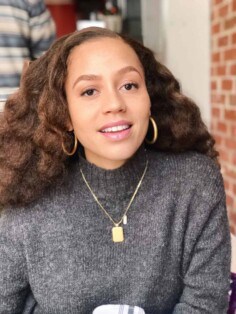
“Through my career process, I’ve come to understand the critical role the humanities play in scientific exploration,” she said. “Being a nuclear engineer, I’ve always been interested in security-related questions, and that requires a real understanding of history, ethics, cultures, and sociology. It’s not enough to know that we can build a system or device. We need to think broadly in the historical context, understand the ethics of our decisions, and see their full breadth in order to know whether we should develop a technology.”
A case in point are the bombings of Hiroshima and Nagasaki. “We just observed the 75th anniversary. That’s an example where there could have been more thinking about the technology’s implications before it was used in warfare,” Dr. Robinson Snowden said. “There were scientists in the Manhattan Project, trying to ask nontechnical questions about ethics and the rule of law in the implications of their work. To me, that’s the natural marriage of technical questions with broader humanities questions that lead us, or should, down that path of curiosity. It’s as if the humanities make appropriate boundaries for our curiosity, because not every discovery is a good thing.”
She chose nuclear security for her Ph.D. work because of its interdisciplinary nature. “Nuclear weapons and security issues are not just technical. To be proficient or efficient, you must be literate in the history between countries — you have to understand cultural differences, the way that disarmament or deterrence is viewed, how governments influence thinking about technology and its use. It’s always been an exciting domain for me because the ground is always moving.”
Dr. Robinson Snowden respects policymakers, whose work involves aspects of law, ethics, and history. “Fortunately or unfortunately, there’s no right answer, and often many options. It’s not objective, like a quantum mechanics derivation. To me, the most promising space is at the intersection of the technical and the arts — where we can merge and sync together.”
She described her graduate work in verification technology as an example. “Say the U.S. and Russia decide to negotiate a new arms control agreement that limits the size of their arsenals. Because there’s a lack of trust and a history of military competition between these two nations, they don’t take each other’s word for it. Verification is proof of that compliance.

“From a technology perspective, we already have close to all the technology we need to answer most verification questions — is it a nuclear weapon, what type of missile? Where it gets ‘sticky’ is when countries are careful about what they disclose. They see themselves as competitors, so they refuse technology that’s too intrusive. Cold War sociology — the full story of the U.S. and the then-Soviet Union was an important constraint on my technical work. I had to learn why we couldn’t detect low-energy gammas from weapons-grade plutonium — that it could reveal information that either country might not be comfortable disclosing.
“As a technical person, I had to understand those boundaries so that I wouldn’t create technology that would be nonnegotiable in the real world. That’s where I need the influence of the liberal arts and humanities, and I went as deeply into them as I could while also getting a nuclear engineering degree.”
Dr. Robinson Snowden also enjoys the fine arts. “I was a ‘slow burner’ in engineering,” she said. “I wasn’t interested in it before college and was very attuned to my creative side, enjoying singing and dancing and drawing. I’m very slow to accept that you have to ‘plant your flag’ in a specialty that’s right-brain or left-brain. I want to use both.”
She counts Cuban-born abstract expressionist Carmen Hererra among her inspirations. Herrera painted for many decades but did not sell a single painting until 2004 at age 89. She still paints today at the age of 105.
“Even beyond her art, her lived experience inspires me. We put a premium on people who peak very early, like the 6-year-old savant or the 21-year-old startup queen. There are so many stories of those who tinkered and refined their craft over a lifetime, people who are diligent and disciplined in their craft for its own sake, whether or not the world acknowledges them. I can relate, because so much of science is sitting alone at the table, doing the analysis and grinding through the code, trying to find the bug. It can sometimes be hard to stay focused. Learning her story refreshed me in my own work.”
Being a historic “first” in her own right, Dr. Robinson Snowden feels fortunate to have a father who loved history. “He instilled in us the need to know our history. He was aware that the dominant narrative about our gender and culture as African American women wasn’t one of empowerment and celebration. Having a narrative to contest that is a matter of spiritual life or death, in terms of being able to persist. I was fortunate to be raised in that and also to go to an HBCU, whose identity is steeped in history. I’ve been shaped to acknowledge, understand its importance.”
Curious about the artists mentioned here? Get inspired at http://kennethsnelson.net/sculptures; http://www.calder.org/work/by-category/hanging-mobile; http://www.the100yearsshow.com/#carmenherrera; and at SOM’s project gallery: https://www.som.com/projects.
Origami Everywhere: Big Things in Small Packages
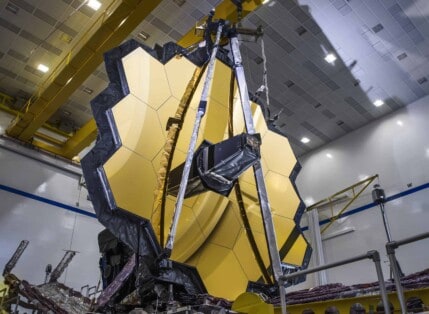
Origami is central to the stents that hold arteries open, the air bags in steering wheels, and the parachutes that bring us gently down to Earth. It’s even inspiring artificial tissue devices for testing future medicines (“Engineers Fold Art into New Devices,” SWE Magazine, Fall 2020). Now, the ancient art of paper folding is helping develop robots that perform complex microsurgery, and telescopes that explore the unknown origins of the universe.
The “mini-RCM” is a new surgical robot, developed by researchers at the Wyss Institute of Harvard University and collaborating with Sony Corp. It’s the size of a tennis ball and weighs about as much as a copper penny — and it recently performed a mock eye surgery procedure, by puncturing a synthetic tube only twice the width of a human hair. Compared with hand-controlled operation, the mini-RCM was 68% more accurate in microscopic testing.
Its “remote center of motion” action, where a mechanism can rotate around a remote fixed point, is origami inspired. Made with a manufacturing technique developed at the Wyss Institute called Pop-up MEMS, its materials are deposited on top of each other in bonded layers, then laser-cut in its origami pattern, allowing it to “pop up” into a 3D instrument.
The mini-RCM’s flawless initial performance and efficient manufacturing raises hope for replacing today’s room-size machines, much in the way microprocessors blew past the laboratory-filling ENIAC.
Meanwhile, NASA engineers have found an answer to the question: How do you make something that’s enormous at its destination small enough to make the trip?
The James Webb Space Telescope (JWST) is a joint venture between the U.S., European, and Canadian space agencies. When it launches from the European Spaceport in French Guiana in October 2021 (the schedule is COVID-19 dependent), it will be the most powerful telescope ever built. Reaching an orbit about 1 million miles from Earth, it will send back images of stars and galaxies, and perhaps, exoplanets, never before seen. Gathering and focusing their impossibly faint light will be JWST’s huge primary mirror, protected by a five-layered sunshield the size of a tennis court.
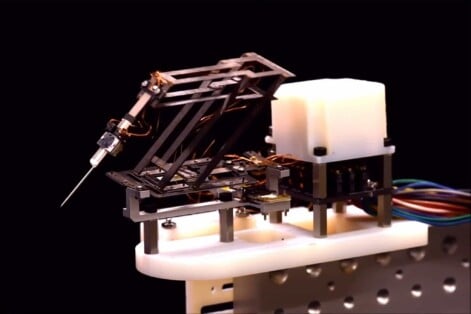
How did engineers pack all that into the 5-meter-wide payload fairing of an Ariane 5 rocket? Origami. The mirror is designed to fold into a neat stack of 18 interconnected, hexagonal segments, made of gold-plated beryllium that can withstand temperatures of –400 F (–240 C). Once the shield deploys, the mirror will unfold into a shimmering honeycomb, 21 feet in diameter, and begin observing galaxies 13 billion light-years away.
The math behind beautiful origami objects has real-world engineering applications, and its rules apply whether a device unfolds in a blood vessel or in outer space. Where will it take us next?
Curious? Create your own origami Webb Telescope mirror from a single sheet of paper with this pattern (courtesy of Robert J. Lang): https://go.nasa.gov/2RKzGLG



